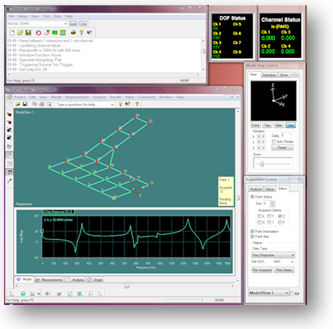CATS Modal integrates all the functionality of STAR Modal into our Computer-Aided-Test-Suite of applications, combining acquisition with analysis for unparalleled power and efficiency.
Data Acquisition
Integrated data acquisition makes acquiring and managing large sets of modal data easier than ever. Automated management of measurement DOF simplifies data acquisition for multiple data sets and reduces test time. A built-in signal generator provides user-specified excitation type (random, sine, chirp, burst random, user-defined) and amplitude control. Upgrading to Premier Modal Data Acquisition adds the ability to acquire multiple-input, multiple-output (MIMO) modal data.
For acquisition of long time history events, the optional removable SCSI throughput disk provides simultaneous acquisition of time data to disk for up to 128 input channels at up to 51.2 kHz sample rate per channel.

Data Analysis
By integrating data acquisition with analysis, CATS Modal simplifies the data acquisition task and provides the same powerful function data viewing capability for both data acquisition and analysis. Function data displays include:
- Multiple graphs per page
- Overlay up to 6 data traces per graph
- Multiple page reports
- Optional 3D waterfall displays
- nth octave analysis
The optional Virtual Calculator can even provide math processing of live data streams and stored data files for complete flexibility in signal processing. Optional modules for Transient Analysis (SRS) and Swept Sine Analysis give CATS extremely powerful and versatile signal analysis capabilities.
STAR Modal
Analyze and Solve Structural Dynamics Problems
Fully analyzing and solving structural dynamics problems require the power of modal analysis, which separates mode shapes from the overall dynamic response of the structure. The robust modal analysis features of the STAR6 System™ reflect over 15 years of technological leadership.
Identification of Modes and Modeling
Creating a modal model from FRF measurements involves two steps: identifying the mode locations and accurately estimating the modal parameters of frequency, damping, and residues. The STAR6 System™ provides both capabilities, giving you a variety of options.
To identify mode locations, the STAR6 System™ uses hybrid summation functions that help locate all of the modes in a data set, even if some are not present on a given measurement.
To accurately estimate modal parameters, the STAR6 System provides the widest variety of curve fitters in the industry.
Simple peak curve fitting methods (coincident, quadrature, and complex peak) provide quick insight into mode shapes. Local single mode (SDOF) and multiple mode (MDOF) polynomial curve fitters are effective for in depth analysis. The global curve fitter is the best solution for modes that are heavily coupled, have high damping, or have many antinodes. The SDOF, MDOF, and global curve fitters consider out of band residual effects to ensure maximum accuracy.
After you identify the location of modes and the type of curve fits, the STAR6 System™ automatically processes the entire measurement data set.
